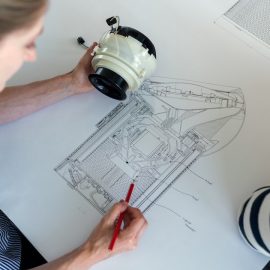

This article is an excerpt from the Shortform book guide to "Sam Walton: Made in America" by Sam Walton. Shortform has the world's best summaries and analyses of books you should be reading.
Like this article? Sign up for a free trial here .
What was Sam Walton’s leadership style? How did Walton keep the small-store feel even when Wal-Mart had thousands of stores?
Sam Walton had a “whistle while you work” attitude. He trusted his employees, encouraged open communication, held managers to the same expectations as their underlings, and more. This created a close-knit company culture in Wal-Mart’s early days.
Keep reading for more details about Sam Walton’s leadership style.
Sam Walton’s Management Style
Sam Walton’s leadership style was to have a trusting, light-hearted attitude. Even when Wal-Mart had 5,000 stores, he wanted it to feel like when they had 5 stores.
Trust People as Partners
Walton’s leadership can be summarized in one line: “Pick good people and give them maximum authority and responsibility.”
Walton preferred hiring ambitious, entrepreneurial people. Even if someone seemed too inexperienced or lacked knowledge right then, they were recognized for their potential if they had the desire to work hard.
Walton gave people autonomy. Wal-Mart locations operated as a “store within a store”—within a single store, each department had a manager who essentially operated her own business. They were given financials, such as cost of goods sold, margins, and expenses, and their performance was ranked against all other stores in the company. They were then given incentives to win.
Walton believed positive feedback was important. He actively looked for things to praise and let people know how important they were. People want to feel appreciated for their performance.
- “Nothing else can substitute for a few well-chosen, well-timed, sincere words of praise. They’re absolutely free—and worth a fortune.”
Other tips:
- When talking with employees, ask them how they feel and what’s on their mind. This leaves a strong impression of a personal connection.
- Keep your doors open to the most entry-level associate. Make them feel empowered to drive to headquarters and meet with you. Even if most people never do this, the knowledge that it’s acceptable makes everyone feel heard.
Find Ways to Motivate Your Partners
In addition to having financial incentives, Walton instilled his love of competition to his team:
- He set high goals, encouraged competition, and kept score.
- He made ambitious bets on company performance, with outrageous payoffs.
- He had managers switch jobs with one another to stay challenged and learn more dimensions of the company. “The best executives have touched all the bases and have the best overall concept of the corporation.”
Saturday Morning Management Meetings
Wal-Mart long had the tradition of holding management meetings on Saturday morning. Hundreds of senior executives would attend, celebrating successes, discussing company strategy, and finding areas of improvement.
Why the odd time? Walton felt that if store associates had to work on weekends, then the managers at headquarters should show up on Saturday too.
Instead of talking at a high-level, the group dove deep into individual stores, the smallest operating unit of the company. They would talk about how the store was doing against a single competitor in its market, how single items were selling, and what specific practices could be shared with other stores.
Sam Walton believed novelty in each meeting was critical to compensate for its imposition on the managers’ weekend.
- Famous guests like Jack Welch would sometimes appear and be Q&A’d.
- He sometimes asked specific execs to lead the meeting.
- Sam might read from management articles.
(Shortform note: In 2008, these meetings were reduced in frequency from weekly to monthly. They were then made optional in 2014.)
Don’t Take Things So Seriously
Walton felt it was important to have fun, not to walk around scowling all day “pretending you’re lost in thought over weighty problems.” He preferred a “whistle while you work” philosophy. People should know that they’re supposed to have a good time working.
This spirit was inherited from their small-town roots: a love of parades, cheers, songs, and celebration.
In the early days, this was a way to attract attention in small towns—they made Wal-Mart the best entertainment you could get in the area. The big shopping day for the family was Saturday, and stores needed to attract customers to their stores above others. Walton’s stores employed a host of promotions, such as:
- Hiring bands and circuses to perform in parking lots
- Moonlight Madness sales, with new bargains announced every few minutes
- Shopping cart bingo—Carts with numbers that, if chosen, got a discount
- Boxes of candy to customers who traveled the farthest
This love of fun spilled over into general management practices:
- Sam Walton bet the company in 1984 that if they made 8% in pretax profit, he’d do a hula on Wall St. They did, and he did a hula. He was embarrassed.
- They have a Wal-Mart cheer inspired by the U of Arkansas cheer.
Advice to managers: Have fun. Show enthusiasm. Build spirit and excitement. Capture your team’s attention and keep them interested, make them guess about what’s coming next.
Keep the Store Small
Even as Wal-Mart grew, Walton wanted the company to keep its small-store feel.
In senior management meetings, they focused on how individual stores were doing on individual items. One store’s experience is what is happening to the entire company, times 10,000.
Walton loved listening to individual employees. He particularly liked talking to the truck drivers—they saw more stores per week than anyone else, and they tended to say what they really thought.
Walton also had an allergy for bureaucracy. He wanted to reduce the number of layers in the company, from chairman to the store associates.
He also preferred to solve the root cause of a problem, rather than add on more layers of people as temporary fixes.
- For example, they once faced problems with incorrect merchandise pricing. At first, they fixed this with people holding scanners and verifying the price tags. Sam disagreed with the necessity of this. They eventually improved their back-office procedures to get it right the first time.
Communication Methods
With thousands of stores worldwide, Wal-Mart had to employ communication methods to help associates feel connected to each other. These included:
- Wal-Mart World periodicals
- TV broadcasting in the break room. For instance, this is how Sam announced that store greeters would be instituted at all store locations.
- Saturday morning meetings
- Encouraging visits of local staff to headquarters, and vice versa
- Regularly touching base with all departments of the company
Culture Is Inertia
As healthy as a company culture might be, be aware that once a culture is in place, it becomes an inertial force and can make an organization resistant to change.
For example:
- Wal-Mart resisted hiring college graduates for a long time and even bullied them when hired. They believed that ambition and a tendency to get things done were more important than a college degree. Over time, they realized the advantages that college graduates had.
- Wal-Mart used to assume that store managers were willing to move on a moment’s notice, and so they readily reassigned managers to other store locations. Eventually, they realized this disadvantaged women, and it also punished people with local roots (who might actually have been the best at managing a local store).

———End of Preview———
Like what you just read? Read the rest of the world's best book summary and analysis of Sam Walton's "Sam Walton: Made in America" at Shortform .
Here's what you'll find in our full Sam Walton: Made in America summary :
- The story of Sam Walton and how he started Wal-Mart
- How Wal-Mart grew from a single five and dime store to one of the world's largest companies
- Sam Walton's retail strategies and management advice






